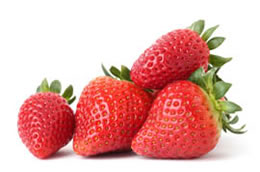Wearing It On Your Sleeve
- By Chris Mittelstaedt
- Reading Time: 2 mins.
I’m not a good poker player. I generally say what I think, and you can read the thoughts I’m not saying across my forehead as if it were an electronic billboard streaming data for all of Times Square to see. One of my daughters seems to have inherited the same gene but with better motor skills. She can roll her eyes back into her head and shoot daggers with the twitch of her brow. Thus it was with much irony that I recently tried to explain to her the concept of wearing emotions on her sleeve and how to control it. “You have to remember that you communicate with more than just words. We need to always be polite.” “But dad,” she said, “I can’t control my eyes when someone says something that’s just dumb.” “Well,” I said, trying to find the right words, “being polite is always. . .“ “Dad, you just rolled your eyes at me.” Busted.

One of the fruits that wears its insides on its outside is the Strawberry. According to my favorite food and kitchen-chemistry writer, Harold McGee:
“The strawberry is unusual in bearing its “seeds” on the surface of the fleshy portion, not inside. The “seeds” are actually miniature dry fruits (achenes) similar to buckwheat and sunflower seeds, and the fleshy portion is the flowers swollen base, not its ovary.”
(FYI – most fruit is the ovary of the plant). Mr. McGee also notes that Strawberries are a “false fruit” in that the seeds are considered entire and separate fruits in their own right. Harold McGee, On Food and Cooking, 2004, page 364, and page 360.
Want fruit for your office?
Get your office a free sample TODAY!There are more than 20 species of strawberries that range across the northern hemisphere. The plants are easy to grow, and you can find them from Sub-arctic to tropical regions. The commercial berries we eat today are much larger than the “wild” berries that are sometimes as small as a fingernail, pithy and fragrant. In the United States, the strawberry industry is mostly located in the southern, central, and coastal areas in California because strawberry production is best suited to moderate climates with warm days and low humidity. The California Strawberry Commission notes that one cup of strawberries has only 50 calories but provides 160% of your recommended daily value of vitamin C. Strawberries are a spring fruit, and we love them at this time of year as we have berry-many direct to farm relationships. Whether you are West Coast, Mid-West or East Coast, you’ll start to see strawberries going forward, and you can see exactly what’s in your box on our In the Mix page at fruitguys.com/mix.
Enjoy and be fruitful! chiefbanana@fruitguys.com


